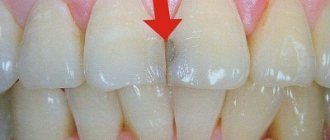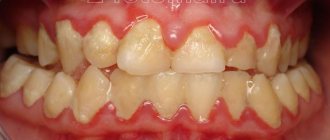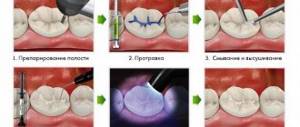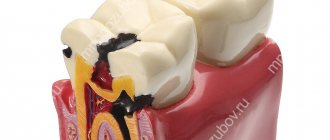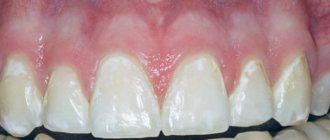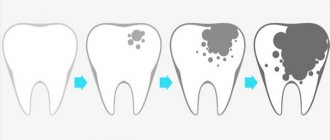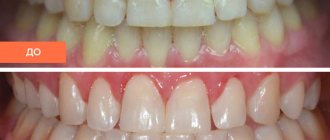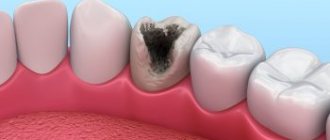1 - superficial caries; 2- medium caries; 3 - deep caries
Of course, treatment of caries in modern conditions is always carried out under local anesthesia, so today there is no need to talk about the pain of this procedure at all.
Removal of carious tissue during dental treatment is carried out in a variety of ways.
The most common of them is the preparation of a carious cavity using a drill. This method still remains universal and widely used, despite the fact that it is far from the most favorite for patients in dental clinics.
It must be said that along with traditional filling of carious cavities, the Best Dentistry clinic uses sound filling. We use a sonic tip (Germany) for this.
The essence of the method is that a special filling material becomes liquid under the influence of a sound wave and is supplied by a tip under pressure, which eliminates the formation of pores in the filling. When the sound wave is turned off, the material transforms into a thicker and more plastic state, which allows the doctor to model the future composite filling in the most convenient consistency.
Therapy room
Dental treatment can also be carried out using the water-air-abrasive method.
In this case, the removal of carious tissue occurs through a mixture of water, air, and a special abrasive powder. This spray gently removes softened tissue without damaging healthy tooth tissue. Treatment of dental caries using air-abrasive technology is significantly less painful than traditional preparation. Therefore, local anesthesia is usually not required.
In addition to the above, the so-called “chemical” method of treating dental caries using the drug “Karisolv” is used. First, the cavity is treated with Carisolv liquid, and then the demineralized tissue is removed with a hand instrument without a drill. At the last stage, the teeth are filled with a composite material, and dental treatment is considered complete.
Unfortunately, unlike preparing a carious cavity with a drill, the last two methods are applicable only at the initial stages of caries development.
Is it possible to treat caries without using a drill?
The drill has been used in dentistry for quite some time. This tool was able to replace hand drills, which were used in ancient times. These devices could not completely clean all the affected tissue. And the use of a drill made it possible to carry out the preparation process more efficiently.
But despite this, this device has many disadvantages:
- During treatment with a drill, microcracks may appear on the enamel surface, which cause the appearance of secondary carious lesions;
- Tooth preparation is usually accompanied by discomfort, pain and vibration;
- In the area of contact of the drill, tissue damage is observed as a result of strong heating;
- During drilling, in addition to the affected tissue, healthy tissue is also removed;
- When preparing with a drill, an increased amount of dust is generated. This dust must be washed out with phosphoric acid, which prevents further development of carious lesions;
- When drilling, there is an increased likelihood of damage to the soft tissue of the gums and palate by the drill.
A drill is what we see when we enter a dentist’s office. Thanks to this installation, high-quality dental treatment is carried out by removing affected tooth tissue.
Currently, special treatment methods have been developed that are carried out without the use of a drill. These procedures allow you to quickly and, most importantly, painlessly cure caries and prevent its further spread.
Causes
Caries is the result of the activity of pathogenic microflora in accumulated plaque or tartar. A person’s immune status plays a major role in the development of carious defects. At particular risk are persons with autoimmune pathologies, AIDS, HIV, metabolic disorders, diabetes mellitus, and those taking immunosuppressive therapy for organ or tissue transplantation for a long time. The following factors can contribute to the development of caries:
- smoking, alcoholism;
- inadequate oral hygiene;
- natural aging (decrease in the body’s defenses, changes in the biochemical properties of saliva);
- metabolic disorders;
- endocrine pathologies;
- lack of food discipline (including prolonged fasting, poor nutrition, anorexia, bulimia);
- gum recession of various nature;
- excessive consumption of sugar and carbonated drinks;
- gastroesophageal reflux;
- bite pathologies;
- violation of hygiene rules when wearing braces and other orthodontic structures for the treatment of pathological occlusion.
Despite the variety of causes, eating disorders, bad habits and organ pathologies are the main etiological triad leading to the development of caries. Caries is not an independent disease. The pathogenetic link in the demineralization of enamel and destruction of the tooth body is a violation of the body's defenses.
Features of caries treatment ICON
The procedure using ICON (Aikon) allows you to cure carious lesions at the initial stage of its development. During this process, a special polymer composition, Icon, is used, which quickly restores the structure of dental tissue.
During the initial stage of carious lesions, a process of demineralization occurs in the structure of the tooth enamel. As a result, the fabric becomes porous under the influence of organic acids, which are produced by various pathogenic bacteria. ICON penetrates deep into the structure of tissues, thereby restoring their density and making them resistant to organic acids. This process is achieved by replacing damaged natural cells with polymers. The drug has no effect on the structure of healthy cells.
Icon technology is a new word in the treatment of caries; it manifests itself as spots on the surface of the teeth, which indicates the activity of harmful bacteria. The principle of operation is to fill the affected areas with a polymer composition, it seals the affected cavity and stops the proliferation of bacteria.
Moreover, this procedure takes very little time. It takes 15-20 minutes and is carried out in one visit to the dentist. How this treatment method is carried out:
- First of all, a special etching gel based on amino acids and sodium hypochloride is applied to the damaged surface of the tooth enamel. This remedy will help remove all damaged tissue;
- Next, after removing the damaged tissue, thorough washing and disinfection with special preparations is carried out;
- Then everything is thoroughly dried;
- A composite mixture is applied to the site of the carious lesion and everything is polymerized with an ultraviolet lamp.
After this procedure, the tooth structure remains completely healthy, it retains all its properties for many years. At the same time, no trace of caries remains. However, this treatment method is recommended to be used only at the initial stage of the lesion; for moderate and deep lesions, this treatment method is not effective.
Classification and stages
The development of caries goes through several successive stages. The disease is classified not only by stage, but also by location and cause of occurrence. The stages of caries are of particular importance:
- Stage I. Formation of stains and clouding of the enamel layer. There are no visible destructions, the tissue structure is not changed. Sometimes the spot disappears on its own, which is associated with increased immunity.
- Stage II. Superficial caries. The enamel undergoes pigmentation, and when examined with instruments, a softening of the structure is felt. Often, superficial damage to a tooth covers all layers of enamel, but is limited. Dentin is still not involved in the pathological process. Visually, a carious defect looks like a dark gray spot with a rough base.
- Stage III. Average caries. The defect becomes pronounced, the lesion covers all layers of enamel and part of the dentin. Patients are increasingly noticing bad breath and discomfort when drinking or eating.
- Stage IV. Deep caries reaches the pulp membrane and is accompanied by tooth sensitivity, pain during chewing or at rest. The pain radiates to the temporal regions. The pain can be acute, throbbing, moderate, persistent. It intensifies and subsides involuntarily.
Typically, patients seek help from a doctor when symptoms worsen the quality of life and the dental-root system atrophies. When examining the oral cavity, caries is classified into:
- localized or generalized;
- acute or chronic;
- complicated or uncomplicated.
Carious lesions can be primary or secondary. In the first case, the disease occurs for the first time, in the second, caries develops again, under a filling, crown, bridge, or veneers. Clinically, there is another classification of caries according to Black:
- Class I or fissure caries - characterized by deepening of the natural grooves of the enamel on the chewing surface;
- Class II or carious defect of molars - the formation of defects on the contact surfaces of premolars, molars;
- Class III - damage to the canines and incisors without the defect extending to the cutting edge;
- Class IV - the edges of the canines and incisors are involved in the pathological process;
- Class V - the formation of cervical caries in any group of teeth.
Other types of caries are described in the international classification of diseases. There are unspecified or other caries, odontoclasia (atrophy of the root part of milk teeth), stopped caries after hygienic cleaning, preventive sanitation of the oral cavity.
Features of caries treatment with ozone
Attention! The method of therapeutic treatment of carious lesions with ozone is another method of eliminating lesions without a drill. Essentially, this procedure consists of disinfecting tissues with lesions.
The thing is that under the influence of ozone, pathogenic bacteria are completely destroyed. During this treatment, a special device is used that converts oxygen into ozone.
How is it carried out?
During therapeutic therapy using ozone, the use of preparation and cleansing of damaged tissue with a drill is not required.
But it is worth noting that if caries has affected the dentin area, but the hole in the enamel is small, then in these cases it is necessary to expand this area to provide convenient access. In addition, drilling of the tooth may be required in case of extensive destruction and softened tissues, because it will simply be impossible to install filling material on them. The procedure for restoring a tooth with ozone is carried out according to the following scheme:
- The first step is to clean and prepare the tooth. During this process, special antiseptic drugs are used;
- A silicone gasket is placed over the tooth. It should fit snugly to the surface of the tooth;
- After this, using a special device, the air is pumped out from under the gasket, this will ensure an even tighter fixation;
- Ozone comes in for about half a minute. As a result of this process, all pathogenic microorganisms are completely killed.
Ozone is a strong oxidizing agent; it penetrates into tooth tissues affected by caries, without affecting healthy cells, as a result, all pathogenic bacteria die. We can say that ozone sterilizes the tooth, preventing the possibility of recurrent disease.
Indications and contraindications
The treatment method using ozone is the most optimal way to combat carious lesions in children, especially at an early stage of the lesion. This method can be used in the first stage of caries, which occurs in the form of a white spot. At the middle and deep stage, it is necessary to additionally remove the affected and softened tissue. This procedure is not accompanied by pain or other unpleasant sensations, so it will not cause fear in children. In most cases, children tolerate this treatment method well. This method of treatment can also be used in traditional therapy for eliminating moderate caries. Ozonation can be used for children and adults. During this procedure, no allergic reactions occur, and ozone has no toxic effects. Using this method once every six months as a preventative treatment will help avoid the occurrence of caries in both children and adults.
Classical methods of therapy with preparation
Previously, when there were no modern methods of filling teeth, caries was treated invasively or by preparation, as well as by forming a cavity for filling material. But in order for the material to be securely and permanently fixed, the specialist needed to fulfill a number of conditions for the following reasons:
- large area of excision of destroyed tissue;
- treating teeth untouched by caries and creating cavities;
- applying trims and cuts with burs;
- determining the shape of the cavity;
- compliance with the rules when forming the transition between the shape of the bottom and walls.
To carry out treatment in this way, the specialist must have extensive experience and knowledge. Previously, dental clinics used the following types of materials, which are still used today as budget options for permanent fillings:
- Amalgams are metal fillings;
- Acrylic oxide – fillings made from epoxy and acrylic materials;
- Silidont, Silicin - filling is done using mineral cement.
In practice, it is clear that before modern methods and materials used for the treatment of caries appeared, several decades passed during which classical materials were used.
Features of air-abrasive processing
Damaged tissue with carious lesions can be removed not only with a drill drill, but also with a strong air stream. When a strong air flow is applied, complete removal of the affected layers with small particles is observed. During this process, a special dental sandblasting device is used, and aluminum oxide is used as an abrasive.
The power of this device is designed so that during treatment, the affected tissues are washed out under the influence of air-abrasive treatment. But at the same time, solid healthy tissues are not affected. The working process of this device is carried out in impulsive mode at intervals of 5-10 seconds.
Positive and negative qualities
Treatment of caries with an air-abrasive device is the cleaning of cavities affected by caries with a stream of abrasive particles and air directed at the teeth through a special tip. Particles of corrosive tissue are sucked out using a special device.
Air abrasive processing has the following positive qualities:
- During this procedure, the patient does not feel pain, so there is no need to use special painkillers during this procedure;
- The whole process takes place in silent mode, there is no vibration and no unpleasant odors;
- Can be used to treat carious lesions at any stage;
- There is no overheating or hypothermia of the pulp;
- The entire treatment procedure takes place in one session;
- It has good effect and quality. In the subsequent period, the filling lasts for a long time.
However, not every area can be treated with the air abrasive method. Sometimes it is necessary to use a drill, especially for hard-to-reach areas. Also, tooth sensitivity often increases after this procedure.
Air sanding
In modern dentistry, there are different ways to replace the drill when treating affected areas of the teeth before installing a filling. One of them is the use of air to grind the tooth surface (microabrasive processing). With air, microscopic abrasive particles are supplied to it, which grind the tooth, removing the affected parts of the tissue. The method is characterized by high precision directed air flow, which helps protect nearby tissues from damage. This method is recommended for use in the early stages of caries.
Symptoms
Symptoms of caries are determined by its stage and location. Patients practically do not notice the initial stage of the disease, especially if the affected area is outside the smile line or on the inner surface of the tooth. However, pay attention to:
- enamel roughness;
- change in shade;
- minor defects (deepening of fissures, cavity fragments).
As the carious process develops, defects become noticeable upon visual inspection, and the cavities deepen. Patients note an unpleasant odor from the mouth, even stench, mainly in the morning. Pain appears. When the first signs of caries appear, you should consult a doctor.
Acute caries affects several teeth at once. The enamel softens, crumbles, and the focal fragment has an irregular asymmetrical contour. Soreness accompanies a person almost all day. There is an acute form of generalized caries, when almost all teeth or several units in the jaw row are involved in the pathological process.
In chronic cases, enamel pigmentation comes to the fore. Destruction is sluggish, pain occurs rarely.
Lack of treatment for chronic caries naturally leads to the destruction of the pulpous membrane and the pulp tissue itself, and the formation of a cystic component.
Rules for selecting and making a filling
The key to success when applying a high-quality and durable filling is to follow the technology of its preparation. Even when using high-quality materials, violation of the manufacturing and application protocol sharply reduces its performance characteristics.
The choice of filling depends on the location of the tooth in the dental system, the strength of the chewing load, and the characteristics of the bite. So, if it is necessary to treat teeth along the smile line, the filling should not only be durable, but also aesthetically pleasing and inconspicuous. Dentists choose composite materials, silicates.
Filling a carious cavity as the final stage is performed only after complete cleansing of the prepared area, removal of dentinal fragments, and drying. The absence of moisture and organic sawdust increases the contact of the filling with the natural tooth tissue. After the filling is fixed and completely hardened, the doctor grinds and adjusts it to the anatomical shape (removes excess material, shapes the edges). Once the filling is comfortable for the patient when closing the jaws, it is polished.
Special attention is paid to polishing. The better the filling is polished, the lower the risk of developing recurrent caries. The uniformity and smoothness of the coating prevents corrosion, accumulation of plaque and tartar, and further destruction.

